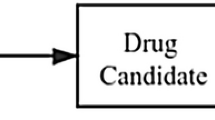Abstract
Structure-based drug design (SBDD) has become an alternative to high throughput screening (HTS) as it reduces experimental costs and time. It works like a funnel, filtering out compounds that do not show good affinity (or score) toward a particular target, with known 3D structure.
Here, we describe a protocol for structure-based drug design using a multi-level in silico approach, combining Molecular Docking, Virtual Screening, Molecular Dynamics Simulations and Free energy calculations to find new lead molecules for experimental testing, predict binding affinities and characterize binding modes.
Access this chapter
Tax calculation will be finalised at checkout
Purchases are for personal use only
Similar content being viewed by others
References
Tang Y, Zhu W, Chen K et al (2006) New technologies in computer-aided drug design: toward target identification and new chemical entity discovery. Drug Discov Today Technol 3(3):307–313
Maia EHB, Assis LC, de Oliveira TA et al (2020) Structure-based virtual screening: from classical to artificial intelligence. Front Chem 8:343
Prieto-Martínez FD, López-López E, Juárez-Mercado KE et al (2019) Computational drug design methods—current and future perspectives. In: Roy K (ed) In silico drug design. Elsevier, Cambridge, Massachusetts
Li Q, Shah S (2017) Structure-based virtual screening. In: Wu C, Arighi C, Ross K (eds) Protein bioinformatics, Methods in molecular biology, vol 1558. Humana Press, New York
Sethi A, Joshi K, Sasikala K et al (2019) Molecular docking in modern drug discovery: principles and recent applications. In: Gaitonde V, Karmakar P, Trivedi A (eds) Drug discovery and development - new advances. IntechOpen, London
Bernstein FC, Koetzle TF, Williams GJB et al (2000) The Protein Data Bank. Nucleic Acids Res 28(1):235–242
Varadi M, Anyango S, Deshpande M et al (2022) AlphaFold protein structure database: massively expanding the structural coverage of protein-sequence space with high-accuracy models. Nucleic Acids Res 50(D1):D439–D444
Kanehisa M, Goto S (2000) KEGG: Kyoto encyclopedia of genes and genomes. Nucleic Acids Res 28(1):27–30
Szklarczyk D, Santos A, von Mering C et al (2016) STITCH 5: augmenting protein–chemical interaction networks with tissue and affinity data. Nucleic Acids Res 44(D1):D380–D384
Humphrey W, Dalke A, Schulten K (1996) VMD: Visual molecular dynamics. J Mol Graph 14(1):33–38
Schrödinger L, DeLano W (2020) PyMOL. Retrieved from http://www.pymol.org/pymol. Acessed 29 Aug 2022
Gaulton A, Hersey A, Nowotka M et al (2017) The ChEMBL database in 2017. Nucleic Acids Res 45(D1):D945–D954
Gilson MK, Liu T, Baitaluk M et al (2016) BindingDB in 2015: a public database for medicinal chemistry, computational chemistry and systems pharmacology. Nucleic Acids Res 44(D1):D1045–D1053
Mysinger MM, Carchia M, Irwin JJ et al (2012) Directory of useful decoys, enhanced (DUD-E): better ligands and decoys for better benchmarking. J Med Chem 55:6582–6594
Sander T, Freyss J, von Korff M et al (2015) DataWarrior: an open-source program for chemistry aware data visualization and analysis. J Chem Inf Model 55(2):460–473
Daina A, Michielin O, Zoete V (2017) SwissADME: a free web tool to evaluate pharmacokinetics, drug-likeness and medicinal chemistry friendliness of small molecules. Sci Rep 7(1):42717
Pires DEV, Blundell TL, Ascher DB (2015) pkCSM: predicting small-molecule pharmacokinetic and toxicity properties using graph-based signatures. J Med Chem 58(9):4066–4072
Empereur-Mot C, Zagury JF, Montes M (2016) Screening explorer–an interactive tool for the analysis of screening results. J Chem Inf Model 56(12):2281–2286
O’Boyle NM, Banck M, James CA et al (2011) Open babel: an open chemical toolbox. J Cheminform 3(1):33
Olsson MHM, Søndergaard CR, Rostkowski M et al (2012) PROPKA3: consistent treatment of internal and surface residues in empirical p K a predictions. J Chem Theory Comput 7(2):525–537
Anandakrishnan R, Aguilar B, Onufriev AV (2012) H++ 3.0: automating pK prediction and the preparation of biomolecular structures for atomistic molecular modeling and simulations. Nucleic Acids Res 40(W1):W537–W541
Maier JA, Martinez C, Kasavajhala KW et al (2015) ff14SB: improving the accuracy of protein side chain and backbone parameters from ff99SB. J Chem Theory Comput 11(8):3696–3713
Frisch MJ, Trucks G, Schlegel HB et al (2016) Gaussian 09, revision A.02. Gaussian Inc, Wallingford
Wang J, Wolf RM, Caldwell JW et al (2004) Development and testing of a general amber force field. J Comput Chem 25(9):1157–1174
Case DA, Cheatham TE, Darden T et al (2005) The Amber biomolecular simulation programs. J Comput Chem 26(16):1668–1688
Roe DR, Cheatham TE (2013) PTRAJ and CPPTRAJ: software for processing and analysis of molecular dynamics trajectory data. J Chem Theory Comput 9(7):3084–3095
Genheden S, Ryde U (2015) The MM/PBSA and MM/GBSA methods to estimate ligand-binding affinities. Expert Opin Drug Discovery 10(5):449–461
Miller BR, McGee TD, Swails JM et al (2021) MMPBSA.Py: an efficient program for end-state free energy calculations. J. Chem Theory Comput 8(9):3314–3321
Lindstrom W, Morris G M, Weber C, et al (2008) Using AutoDock 4 for virtual screening. Available via http://wwwmodekejicn/wp-content/uploads/2019/08/UsingAutoDock4forVirtualScreening_v4pdf. Acessed 29 Aug 2022
Trott O, Olson AJ (2009) AutoDock Vina: improving the speed and accuracy of docking with a new scoring function, efficient optimization, and multithreading. J Comput Chem 31(2):455–461
Jones G, Willett P, Glen RC et al (1997) Development and validation of a genetic algorithm for flexible docking. J Mol Biol 267(3):727–748
Friesner RA, Banks JL, Murphy RB et al (2004) Glide: a new approach for rapid, accurate docking and scoring. 1. Method and assessment of docking accuracy. J Med Chem 47(7):1750–1759
Author information
Authors and Affiliations
Corresponding author
Editor information
Editors and Affiliations
Rights and permissions
Copyright information
© 2023 The Author(s), under exclusive license to Springer Science+Business Media, LLC, part of Springer Nature
About this protocol
Cite this protocol
Vieira, T.F., Sousa, S.F. (2023). Receptor-Based Virtual Screening of Large Libraries in a Multi-Level In Silico Approach. In: Sousa, Â., Passarinha, L. (eds) Advanced Methods in Structural Biology. Methods in Molecular Biology, vol 2652. Humana, New York, NY. https://doi.org/10.1007/978-1-0716-3147-8_15
Download citation
DOI: https://doi.org/10.1007/978-1-0716-3147-8_15
Published:
Publisher Name: Humana, New York, NY
Print ISBN: 978-1-0716-3146-1
Online ISBN: 978-1-0716-3147-8
eBook Packages: Springer Protocols




